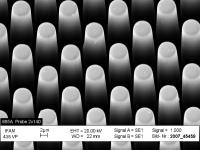
The sensor is covered with 250,000 tiny plastic columns only five microns in diameter. When a cell creeps across the tips of the columns, it presses each column very slightly sideways. Credit: © Fraunhofer IFAM Even the slightest differences are important in competitive sport: To improve a ski jumper's performance, the trainer can analyze the jump very accurately using force sensors. Researchers in Jena and Bremen are planning something similar. However, their work is not with athletes but with tiny somatic cells. The experts have developed a low-cost optical sensor to measure the force with which migrating cells push themselves away from an underlying surface. Force analysis devices like these could one day help to identify specific cell types – more reliably than using a microscope or other conventional methods.
__IMAGE_2 The sensor is the outcome of an EU project. It consists of a smooth surface that is studded with 250,000 tiny plastic columns measuring only five microns in diameter, rather like a fakir's bed of nails. These columns are made of elastic polyurethane plastic. When a cell glides across them, it bends them very slightly sideways. This deflection is registered by a digital camera and analyzed by a special software program. The researchers working with project manager Dr. Norbert Danz of the Fraunhofer Institute for Applied Optics and Precision Engineering IOF in Jena have already shown that their 'Cellforce' sensor works. It will be the task of initial biological tests to show how different cell types behave. "Analysis of cell locomotion is important for numerous applications," says Danz. "It could be used to check whether bone cells are successfully populating an implant, or how well a wound is healing."
Developing the sensor was no easy undertaking. For one thing, the columns have to be coated in such a way that living cells are happy to move across their tips. The cells would otherwise avoid the tips and continue their journey lower down between the columns. In that case, there would be no deflection at all. Danz had the task of adapting the microscope required for cell magnification to make it exactly right for the application. Building the delicate column structure developed by researchers at the Fraunhofer Institute for Manufacturing Engineering and Applied Materials Research IFAM in Bremen is no less tricky: The researchers press liquid plastic at a pressure of 2000 bar into a negative mold and allow it to harden. It is a challenge even to manufacture the required mold, with its 250,000 micron-sized holes. To allow cost-effective production of the 'Cellforce' sensor in future, the researchers utilize commercially available plastics and well-established techniques from chip manufacture. The first 'Cellforce' prototype is expected to be ready in a year's time.
Source : Fraunhofer-Gesellschaft
 Print Article
Print Article Mail to a Friend
Mail to a Friend
